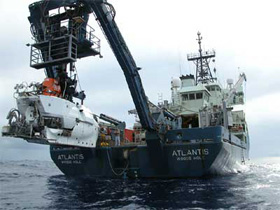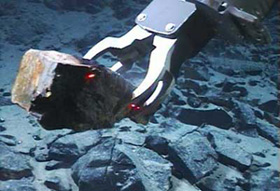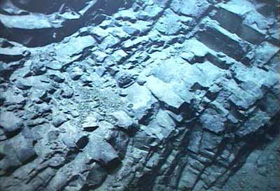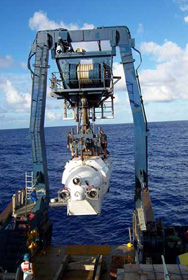Exploring the Ocean's Geology
Air Date: Week of February 25, 2005
Living on Earth host Steve Curwood talks with scientists at sea in the eastern Pacific Ocean. With the help of a submarine named Alvin and a robotic craft called Jason II, they're exploring an underwater canyon called Pito Deep and hope to uncover some of the mysteries of the ocean floor.
Transcript
CURWOOD: Our next guests are a couple of scientists who have hit bottom. The bottom of the sea, that is. In their research vessel the Atlantis, anchored just west of Easter Island in the Pacific Ocean, they are exploring Pito Deep, an underwater chasm, to get a glimpse into the geology beneath the ocean floor. The research submarine Alvin and a robotic called Jason II, allow a small crew to travel about two and a half miles beneath the ocean surface to go into Pito Deep and take pictures and collect samples of rocks and lava from the earth's crust.
Emily Klein is co-chief scientist of the expedition and a geology professor at Duke University. She joins us now from aboard the Atlantis.
Professor Klein, welcome to Living on Earth.
KLEIN: Thank you for having me.
CURWOOD: Now, what's a group of geologists doing out in the middle of the ocean?
|
Alvin is launched from the Atlantis. (Photo courtesy of Woods Hole Oceanographic Institution.)
|
KLEIN: Well, 70 percent of the earth's crust is covered by water and so a great deal of geologic interest on the earth takes place on the ocean bottom.
CURWOOD: You're out at this deep underwater chasm, described as an underwater Grand Canyon, called Pito Deep. What actually is Pito Deep? KLEIN: Pito Deep is an unusual place in the ocean where, if you can imagine that, imagine the ocean crust being something like a layer cake. Normally, you can only see the top of the cake, that is to say, the icing, but we're particularly interested in looking deeper into that cake into the known layers of the igneous crust below the surface and normally you can't see that. But there are certain places in the ocean where due to some unusual tectonic forces, in this case, a large fault, a rift, has opened up a deep, wide chasm that allows us to look at the deeper layers of this cake or this ocean crust. And the Pito Deep is one such place. CURWOOD: So, these places are found only in the ocean? There's no place on land that you can see this kind of formation? KLEIN: There are rifting places on land, certainly. East African Rift is one of those places, but the ocean crust is unique. It's different from the continental crust, entirely different in chemical composition and in structure. And so, if we want to look and study the ocean crust we have to go to the oceans. CURWOOD: Professor Klein, your research ship, the Atlantis, is using two types of vehicles to explore the ocean floor and in a few minutes we're gonna talk with a scientist in Alvin the submersible, but there's also Jason, a robotic. Tell me about the differences between the two, what they're used for, what they look like.
|











